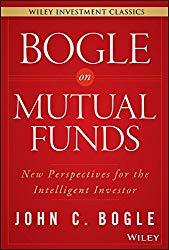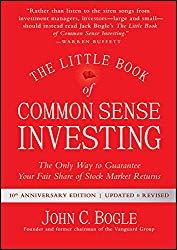Many people would never consider investing in anything but index funds, citing studies that most fund managers don’t beat their benchmarks, which is true. But index funds have their own issues, sometimes making a managed fund a better choice. Other times you can still use index funds, but be picky in their choosing to improve your results. Sometimes it even makes sense to add a few individual stocks to your portfolio in addition to your index funds. Let’s look at why.
(Note, if you click on a link in this post and buy something from Amazon (even if you buy something different from where the link takes you), The Small Investor will receive a small commission from your purchase. This costs you nothing extra and is the way that we at The Small Investor are repaid for our hard work, bringing you this great content. It is a win-win for both of us since it keeps great advice coming to you (for free) and helps put food on the table for us. If you don’t want to buy something from Amazon or buy a book, how about at least telling your friends and family about our website as a great place to learn about investing and personal finance. Thanks!)
Before we get started, let me say that this is a more advanced article on investing that assumes the reader is an old hack at investing in mutual funds. If this is not you, please consider reading How Do Index Funds Work for a primer. You can also read some of the articles under Investing/Beginner Investing Class. Finally, you can check out these great books by the father of the index fund, Jack Bogle:


The main issue with index funds is how the indexes themselves are constructed. In the beginning of the development of indexes, a set of stocks are selected to represent some sector of the economy. For example, the S&P 500 index was designed to represent the large US companies. The NASDAQ Q’s was designed to represent the technology companies. The whole idea is to have a way to see how each sector of the economy is doing by following the value of the index for that segment of the economy.
Because you want the index to do what each segment of the economy is doing, such that the index goes up when that segment of the economy is doing well and down when it’s struggling, the weighting (how much of each company makes up the index) of the index is designed to match the weighting of the companies in that sector. This means that if a company is a dominant player in that sector, the index will contain more of it than a less dominant player. For example, in technology Apple
When investing in funds, however, you really are trying to match the returns of the market. You’re trying to spread your money out over a large number of companies so that if anything goes wrong at a particular company you won’t see too big a loss. If you buy into a NASDAQ index and Apple were to have a huge scandal or make a huge misstep and close their doors, you’ll lose about 15% of your portfolio value. It might be OK to have a little more Apple in your portfolio than some of the really small companies in the NASDAQ since, obviously, Apple is a great company. Having 15% of your portfolio in Apple, however, may be a bit much.
It’s hard to go small with index funds
One area that is particularly an issue is small-caps. (Small-cap stands for “Small Capitalization.” These are small companies.) When you’re buying a small-cap fund, you’re trying to get small companies because they have a lot of room to grow, as opposed to big companies, or large-caps, which have already gotten into most markets and therefore are limited on how fast they can get bigger. For example, a company like Walmart already has stores in basically every significant community across the US and many around the world. It would, therefore, be very difficult for Walmart to double in size. A small burger joint in one city with three locations, however, could easily open up three more restaurants and double in size.
The issue with buying a small-cap index fund is that, once again, they tend to have higher amounts invested (a greater weighting) in the larger small-cap stocks. This means that instead of buying a lot of small companies, you’re buying mainly stocks that are almost big enough to be considered mid-caps. You’ll notice that if you compare the performance of a small-cap index and a mid-cap index, they’ll do about the same. This is because they’re really invested in about the same sector of the market.
Here, a fund manager can choose to put more money into smaller companies because he/she is actually buying shares of stock and determining the mix of the portfolio. In addition, because there are so many small companies out there, he/she can spread the money out a lot more in the small-cap area than he/she can in the large-cap area. Another place where a good fund manager can make a difference is in the international stock category since he/she can pick better areas of the world to invest in rather than just buying everything blindly because it’s in the index.
Just because you should sometimes go managed, doesn’t mean any managed fund will do
So, while indexes with their low fees are normally the best option, there are times when it’s worth it to consider a lower-cost managed fund. This does not mean that any managed fund would be preferable to an index fund in these areas. There are a lot of funds that are over-priced or have managers that don’t do a good job with their management.
You should only buy funds that have no up-front costs or redemption fees. These are called no-load funds. While managed funds will cost more than index funds, you should also pick relatively inexpensive funds, keeping the yearly fees to less than about 1.25%. You should also look at the portfolio turnover rate, which shows how often the manager is buying and selling shares. You’ll want a long-term investor rather than a manager who is trying to time the markets, meaning that you’ll want the turn-over rate to be less than 25%. Finally, you should review the fund description in the prospectus and look for one that matches your objective of significant diversification and has words like “long-term performance.”
Learning more
To learn a lot more about investing and managing your finances, check out my books, SmallIvy Book of Investing: Book 1: Investing to Become Wealthy and FIREd by Fifty: How to Create the Cash Flow You Need to Retire Early. The SmallIvy Book of Investing provides information on how to determine risk when investing, then goes on to provide strategies for investing with both individual stocks and mutual funds. FIREd by Fifty provides a great deal of information on investing with mutual funds, including mutual fund portfolios you can use to generate income when you’re retired or need cash from your portfolio for some other reason.


Have a burning investing question you’d like answered? Please send to[email protected] or leave in a comment.
Follow on Twitter to get news about new articles. @SmallIvy_SI
Disclaimer: This blog is not meant to give financial planning or tax advice. It gives general information on investment strategy, picking stocks, and generally managing money to build wealth. It is not a solicitation to buy or sell stocks or any security. Financial planning advice should be sought from a certified financial planner, which the author is not. Tax advice should be sought from a CPA. All investments involve risk and the reader as urged to consider risks carefully and seek the advice of experts if needed before investing.
